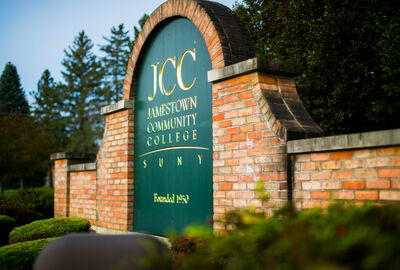“Like something from Star Wars.”
That’s how Angelina Snyder of Jamestown Community College describes new equipment the college is using to kill coronavirus at the college’s campuses in Jamestown, Olean, and Dunkirk.
The equipment resembles a cross between a paint sprayer and a ray gun. Snyder, JCC’s assistant director of buildings and grounds, said the disinfectant guns spray a mist to kill the virus that causes COVID-19.
The mist droplets stick to surfaces being disinfected and kill the virus in one minute.
Her supervisor, Dave Johnson, said classrooms will be sanitized after each class. It takes about five minutes. Desks have been moved farther apart, means classrooms hold fewer people.
“We’ve been as busy as we’ve ever been, and we’re not even open,” said Johnson, JCC’s director of buildings and grounds. “I think our staff has done a great job. They’ve been here every day. The next two weeks will be the test.” Faculty and staff returned to work this week. Classes start August 24.
Coronavirus fighting technology at JCC involves more than the sanitizing guns. A new app screens anyone who wants to enter a JCC building. A limited number of entrances will be open.
Paula Snyder, executive director of JCC’S Cattaraugus County Campus in Olean, said any possible symptoms of COVID-19 “will be a flag to the college health center’s registered nurses, who will call or contact the individual for further discussion” and possibly referrals to the person’s own health care providers.
On another virus fighting front, Johnson and Angelina Snyder have been working since February with Barry Swanson, JCC’s campus safety and security coordinator, to buy personal protective equipment for the college’s employees and students.
Swanson said JCC president Daniel DeMarte activated the college’s emergency response and emergency management teams in March, but this type of situation had been anticipated by college officials years ago.
“We already had a pandemic plan,” he said. “It was part of our emergency response plan. We modified this section of the plan for this emergency.” The pandemic plan was developed during the Severe Acute Respiratory Syndrome outbreak in 2003, when the disease spread to 29 countries. Twenty-nine cases, but no deaths, were reported in the U.S..
“We organized a PPE working group to assess our needs and started ordering PPE right away,” he said. Swanson, a retired Jamestown Police Department captain, said JCC worked with the emergency services departments from Chautauqua and Cattaraugus counties to obtain masks, hand sanitizer, disinfectants, and face shields.
“They were one of the greatest assets we had,” he said. “Christopher Baker and John Griffith (the counties’ emergency services coordinators), were very helpful, and their staffs were very helpful as well.”
Angelina Snyder said Swanson “knows a lot of emergency management people from both counties. That helps us a lot.”
Swanson said dealing with the expense of protective equipment and supplies at this level and volume is new for colleges, but Johnson noted, “We have had the green light to purchase what we’ve needed.”
Angelina Snyder pointed out JCC employees have been “innovative” and tried to be “good stewards of the college’s money. A lot of colleges have been spending hundreds of thousands of dollars and not being innovative.”
For example, JCC workers have built portable hand sanitizer stations, which are scarce and expensive.
“We can move these anywhere on campus,” Johnson said. They’re in prominent places near the campus doors and are also located near all restrooms and in key areas like cafeterias.”
With the nationwide shortage of sanitary wipes, the maintenance staff also figured out how to make their own using shop towels and a sanitizing solution from a company in Rochester.
Once school starts, Paula Snyder said, the college has anticipated some people might object to being required to wear masks (which the college will supply throughout the year). But JCC already has gone through a similar situation.
“We are a tobacco-free college at all our sites,” she said. “We in the Health Center were trained in 2014 to de-escalate situations where individuals were smoking on campus and help them understand why we were doing what we were doing in eliminating tobacco products.
“This, in my view, will be similar,” she continued. “We understand people are so anxious now, and we need to help them understand we are putting everyone’s health and safety first.” Those who choose to not wear masks “are free to take their classes in another medium off campus.”
Obtaining safety supplies has been one worry. How long they will last is another.
“We want to make sure we’ll have more than we need,” Angelina Snyder said.
Paula Snyder added, “That is why we began buying supplies very early, beginning in April and May, utilizing every resource from the state, from our local counties, and from our private vendors.”
After the number of people who will be on campus this fall becomes more definite, it will be easier to tell how long existing supplies will last, Swanson said.
As the buildings and grounds staffers look to keep the campus community safe this fall, “we look out for each other,” said Angelina Snyder. “We’re a tight-knit group.”
Nonetheless, she has worries.
“What keeps me up at night? Safety. This is so new, so different than what we’ve dealt with in the past,” like flu and whooping cough.
When asked how he dealt with the stress of the coronavirus threat, Johnson said, “I’m worried less for myself and more for others. My biggest fear is giving [COVID-19] to anyone. I’d feel awful if I had it and didn’t show signs for several days.”
Snyder said, “I worry about that a lot,” particularly given the advanced ages of relatives like aunts and uncles. “I’m very close to them.”

